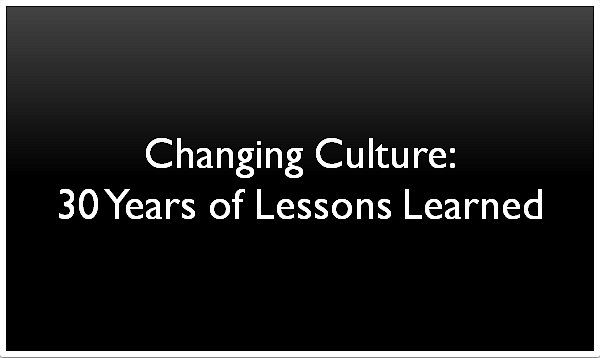
Lesson 3: The Leader’s Culture Change Toolkit
Most leaders already have the fundamental skills required to effectively lead culture change. They are terrific problem solvers and action-oriented. When faced with a challenge, they shift into solution mode relying on personal experience and the advice of trusted colleagues and subject matter experts to identify the best approach for the situation. They search their bank of past successes and lessons learned to identify actions they believe will deliver the desired results. Many of these include behaviors, practices and systemic changes to structures, processes, policies and so on.
This is what Bill did so well as told in the story in Lesson #1. He used behaviors, practices, stories (remember the one about the cell phone and locking the CEO out of the meeting room for showing up late), structure and processes to create a more disciplined culture. In other words, he intentionally used the tools in his personal toolkit to achieve and sustain a significant change in culture.
The Personal Culture Change Toolkit
So, what is the leader’s personal culture change toolkit? Basically, it consists of the tangible elements of day-to-day life in an organization. These fall into two categories: people and environment. People tools refer to the actions that convey what is important and valued to individuals and teams. These are shared primarily through social interactions, such as observation and first-hand experience. The environment tools are the ‘systemic’ elements of the organization that determine the way people work and interact. These are important as their design can either support and encourage the desired behavior or create significant obstacles to adoption.
People Tools
The ‘people tools’ are the actions explicitly directed at influencing people. Behaviors and practices were introduced in an earlier chapter, so I’ll just provide a brief recap. Behaviors are the oft unconscious actions that we demonstrate in response to different situations. These actions send signals that tell others what is expected and, when the leader is influential, the best way to act. For this reason, it is important that leaders are self-aware and in touch with the ways that their words and actions are influencing others’ behavior and shaping the culture around them. Practices are the repeat patterns of activity or routines that leaders use as they go about their day-to-day work. They are different from processes which are the transformation of an input into an output. An example of a practice is the way you run meetings. If you run your meetings in a structured and disciplined manner, it sends a very different message than if your meetings are ad hoc and infromal. Thoughtfully using a mix of practices is an especially powerful strategy for reinforcing new behaviors and shifting culture.
Stories and Heroes
Stories and heroes refer to the telling of events involving people doing exceptional things. This is a powerful way to send a message about what is valued and important. They can be told in formal and informal settings and through a mix of verbal, written and visual media. The more stories about different people doing something that brings the values and desired behaviors to life, the better. The key is they must be authentic, credible and relatable.
 There is a great WestJet Airlines commercial that illustrates this beautifully (https://www.youtube.com/watch?v=o5nfJ_u_8Ws). In the commercial, WestJetter Amanda helps a little girl and her family who find out they can’t bring her pet turtle on the plane. Her solution? She offers to look after ‘Steve’, the turtle, until they return from their vacation. The message is that Amanda is an owner and owners care, which is a core value of the company. This is just one of several videos showing employees going above and beyond to help their customers. It sends a clear message of what is important and valued to employees, customers and any one else who cares to listen. By the way, if you want to really understand your culture, ask people to tell stories about the company at its best and its worse. It is amazing what you will uncover.
There is a great WestJet Airlines commercial that illustrates this beautifully (https://www.youtube.com/watch?v=o5nfJ_u_8Ws). In the commercial, WestJetter Amanda helps a little girl and her family who find out they can’t bring her pet turtle on the plane. Her solution? She offers to look after ‘Steve’, the turtle, until they return from their vacation. The message is that Amanda is an owner and owners care, which is a core value of the company. This is just one of several videos showing employees going above and beyond to help their customers. It sends a clear message of what is important and valued to employees, customers and any one else who cares to listen. By the way, if you want to really understand your culture, ask people to tell stories about the company at its best and its worse. It is amazing what you will uncover.
Traditions and Rituals
Traditions and Rituals are a forum to celebrate the things that really matter. While common in families and religions, they can also be found in organizations usually taking the form of a special event such as a family picnic, annual profit-sharing celebration or Christmas party. To be considered a tradition or ritual, they must be meaningful and endure the test of time. An example is an annual family picnic that emphasizes the importance the company places on employees and their families, as well as the desire to nourish a sense of family and community within the company itself. If the picnic is only held once, it is a nice gesture. When it is a recurring event held for several years, it becomes a tradition.
Traditions and rituals are usually established by founders and other senior leaders, however, leaders at lower levels can also do something meaningful but on a smaller scale. These events rarely become traditions as circumstances can change limiting their ability to endure over time (i.e., budget cuts, staffing changes etc.). Their power is in the potential to augment the global message by making it personal – this leader personally believes in the importance of family and creating a sense of community.
One of the challenges with traditions, and why it is important to be intentional in using them, is they become part of the company’s identity and embedded in the tacit employment contract. As a result, discontinuing a tradition, such as the family picnic, sends a strong, usually negative, message to employees. This is regardless of how good the reasons and how effective you are communicating them. In the end, employees interpret discontinuing the picnic as the company no longer values employees and their families. They point to other things the company is spending money on as evidence that leaders could continue the picnic but are choosing to do otherwise. This is why cost-cutting initiatives that target these types of events should be carefully considered and the consequences evaluated before taking action. In the end, the long-term impact of cutting the family picnic may far outweigh the short-term benefits.
Environment Tools
Environment tools are the elements of an organization that create the conditions to encourage and sustain new values, behaviors and practices. My favorite way to explain this is to consider what it takes to successfully lose weight. I can change my behavior by modifying my eating habits and going to the gym on a regular basis. I can adopt new practices such as weighing myself weekly, tracking my food intake and attending group support meetings. However, if my kitchen cupboards contain my favorite high-calorie snacks and the gym is 45 minutes from home, chances are sooner or later I am going to fall off the bandwagon. The same thing happens in organizations when leaders articulate new values and expected behaviors but don’t make the environmental changes required to support them. Even when significant time, money and attention is invested in initiatives such as communication and training, a lack of aligned structures, processes, policies and so on sends conflicting messages that discourage change and reinforce existing behaviors.
Now, you might be thinking, these are tools that only leaders in senior positions can use. The truth is every leader, regardless of level, can use the environment tools. However, the scope and scale depends on the leader’s role, responsibilities and level of authority. For example, senior leaders are accountable for the overall design of the organization’s structure providing direction including boundaries and limitations for lower level design efforts. Mid-level managers apply these parameters in designing the structure of their area of responsibility and lower-level managers to the design of their teams. The same applies to processes, policies, systems, space and symbols.
Structure
Structure determines who does what and how decisions are made in pursuit of an organization’s goals. It involves the design of roles, responsibilities, reporting relationships and authority levels. This includes temporary governance structures, such as advisory boards and management committees, as well as team structures. Structure has a powerful effect on culture influencing the ways people work and interact within and across levels, teams, business units, functions and geographies.
As an example, organization structures tend to fall somewhere between hierarchical or mechanistic and organic or flat and can take various forms depending on the company’s operating model. Hierarchical structures tend to provide a clear chain of command however, they can contribute to bureaucracy and slow decision-making. In many hierarchical structures, business units operate independently which means collaboration between groups can suffer. On the other hand, flat structures use teams to respond and adapt quickly to challenges and opportunities which is critical in dynamic external environments. While this allows for faster decision-making, it can lead to confusion and inefficiencies especially as an organization grows. If the teams operate independently, which is often the case, there is also the potential for redundancies and breakdowns in collaboration.
 The way functional reporting relationships are designed also affects culture. Specifically, are the functions, such as Sales, Finance and Human Resources, centralized or decentralized? Do the functions report directly to the business units or are they operating as shared service centers providing support to the business units? Perhaps they report directly to a Corporate executive and indirectly to the business units as is common in a matrix structure, or maybe functional roles are fully integrated into project teams as in a flat structure. This is important because the functions own many of the processes and policies that determine the way things get done and thereby affect culture. In some organizations, this includes acting as a ‘gatekeeper’ to ensure consistency and manage risk. Anyone who has had to go through multiple steps to get Legal approval for a contract or business deal knows how this affects culture. Talk about bureaucracy!
The way functional reporting relationships are designed also affects culture. Specifically, are the functions, such as Sales, Finance and Human Resources, centralized or decentralized? Do the functions report directly to the business units or are they operating as shared service centers providing support to the business units? Perhaps they report directly to a Corporate executive and indirectly to the business units as is common in a matrix structure, or maybe functional roles are fully integrated into project teams as in a flat structure. This is important because the functions own many of the processes and policies that determine the way things get done and thereby affect culture. In some organizations, this includes acting as a ‘gatekeeper’ to ensure consistency and manage risk. Anyone who has had to go through multiple steps to get Legal approval for a contract or business deal knows how this affects culture. Talk about bureaucracy!
While the above examples are part of the senior leader’s toolkit, managers can also use structure to intentionally shape culture albeit not to the same extent. Managers and team leaders typically decide who does what and how employees are going to work together to deliver expected outcomes. For example, in transactional roles such as Accounts Payable and Receivable, jobs are usually designed with efficiency of task completion a priority. This results in discrete roles with very structured job descriptions that offer little flexibility or opportunities for personal growth. The culture, at least within this team, places a high value on normative practices such as process consistency and compliance, as well as orderliness and attention to detail. While this might make perfect sense for the Accounts Payable and Receivable department, the same structure applied to a team of Software Engineers tasked with developing new products would be a disaster. For this team to be productive, the culture needs to encourage collaboration, experimentation (including making mistakes), flexibility, adaptability and responsiveness, as well as execution and results. Rather than narrowly defined roles and job descriptions with clear task allocation, a loose and flexible team structure is a much better option.
Systems, Processes and Policies
Systems, processes and policies (“the system”) are the guidelines and integrated methods and procedures that define how work is to be performed and people are expected to behave. This includes boundaries and limitations, as well as best practices. In my experience, a lack of alignment between “the system” and desired behaviors is one of the most common obstacles to culture change. This is notwithstanding the fact many organizations do a good job aligning Human Resource processes and policies to support desired behaviors.
Talent acquisition and management processes, performance management systems, competency models, employee training and manager development programs, as well as rewards and recognition programs, are some of the tools typically used to encourage specific behaviors and help change culture. I emphasize ‘help change’ versus ‘change’, as Human Resources processes and policies on their own are rarely sufficient to achieve the desired results. This is not to say they aren’t important or relevant. They are. The point is that most organizations stop here and don’t make the necessary changes to other parts of the system.
Pretty much every organization has functional groups such as Sales, Legal and Finance. Even small companies have an overarching system of controls to ensure fiduciary, regulatory and legal compliance, at a minimum. As organizations grow, the role of the functions tends to expand and with it their influence over day-to-day work. The need to reduce waste and lower costs, increase efficiency and effectiveness, and reduce risk are just a few of the drivers behind this shift. Now, you might be asking what does this have to do with culture? The answer is a great deal; every function has policies, procedures and processes that affect the way things get done, otherwise known as culture.
Take for example an organization that needs to become more agile in order to compete in an increasingly dynamic and unpredictable marketplace. By increasing agility, the company should be able to respond quickly and adapt to changing circumstances, which is a must in this type of environment. Now, let’s say this same organization is a large, mature global company that insists employees comply with restrictive Finance, Legal and Human Resource policies and procedures when making decisions. For instance, there are strict limits on spending reinforced by delegation of authority (DOA) policies and a rigorous expense approval process. All contracts regardless of the cost, including rental of off-site meeting rooms, require multiple layers of Legal review and approval. Furthermore, senior executives must sign off on all new hires and promotions per Human Resource policies. This isn’t exactly a system designed to foster agility. In fact, some might (and do) call it downright bureaucratic.
How successful do you think the culture change effort will be if these and other relevant policies, processes and procedures remain the way they are? It will fail…100% guaranteed. Even if Human Resources does a terrific job defining the desired behaviors and embedding them in their processes and programs, the change effort will be for not. There is simply too great a disconnect between the desired behaviors and the system. For the company to become more agile, it must make substantial changes to these and other elements of the system at both the macro and micro level.
While the above is an example of the macro level system in action, managers and team leaders play a critical role in identifying the required macro and micro level changes. They work most closely with front-line employees and understand the nuts and bolts of the day-to-day performance of work. If an organization needs to be more agile, it is the lower level managers and front-line employees who can identify the specific changes required to align the system in support of the desired behaviors. Simply asking them what is stopping them from being agile (of course, supported by a clear description of what this means) is guaranteed to elicit useful information about obstacles and potential solutions.
Space
Space refers to the design and use of the physical workplace. It includes micro spaces such as individual and team workspaces; shared spaces such as meeting rooms, cafeterias and collaborative work areas; outdoor spaces such as parking lots, gardens, courtyards and sports fields; and, macro spaces such as building and campus floor plans. Every one of these spaces has the potential to help build and shape culture at the same time as it supports strategy execution and the effective completion of work.
 Let’s say, for example, leaders have identified the need to increase creativity and generate more good ideas in support of innovation. How can the design and use of physical space help or get in the way? Consider for a moment a traditional office building floor plan comprised of walled offices for managers and cubicles for non-managers. These are connected by a hallway that wraps around the central elevator core and stairwell. There are a few meeting rooms located off the hallway also at the core. These are equipped with standard furnishings and decor, such as a table and chairs, speakerphone, screen and projector with computer connections and a few pictures on the walls. Also located at the core are washrooms and a shared supply room that serves a dual purpose providing vending machines that dispense snacks, drinks and coffee. Sound familiar? Space is expensive so companies try to use it as efficiently as possible. This might be fine if people need quiet spaces to focus on their work and complete tasks. However, it is hard to see how this would inspire creativity and idea generation.
Let’s say, for example, leaders have identified the need to increase creativity and generate more good ideas in support of innovation. How can the design and use of physical space help or get in the way? Consider for a moment a traditional office building floor plan comprised of walled offices for managers and cubicles for non-managers. These are connected by a hallway that wraps around the central elevator core and stairwell. There are a few meeting rooms located off the hallway also at the core. These are equipped with standard furnishings and decor, such as a table and chairs, speakerphone, screen and projector with computer connections and a few pictures on the walls. Also located at the core are washrooms and a shared supply room that serves a dual purpose providing vending machines that dispense snacks, drinks and coffee. Sound familiar? Space is expensive so companies try to use it as efficiently as possible. This might be fine if people need quiet spaces to focus on their work and complete tasks. However, it is hard to see how this would inspire creativity and idea generation.
Now, contrast this with a workspace specifically designed for this purpose. Perhaps you envision a Google-type workplace where the design of space encourages people to come together to interact, play and have fun. Alternatively, maybe you’re thinking of war rooms, coffee shops, team layouts, movable walls, learning labs or other spaces designed with creative collaboration in mind. There are lots of options. The art and science is in the intentional design of space to serve a purpose and fit the people and work they are doing. This purpose can and should include building or changing culture in support of your strategy and goals. While space used in isolation of other tools is not enough to change culture, intentional design can help accelerate change, encourage new behaviors and reinforce values.
Symbols
Symbols are the tangible objects or artefacts that we encounter in the workplace. They include signs, awards, product samples, photos, wall murals and basically anything we can see or touch. Their power is in the meaning they hold for the observer, which can be different depending on the context and person. For example, the image at right is a photo of a poster hanging on the wall of a meeting room at a Toronto Public Relations firm. Take a close look. What is the meaning of the poster?

Perhaps you thought the following:
- They are obviously ‘creative’ (and have too much time on their hands)…yep, this was someone’s answer.
- The hands look like they are from members of a team who probably did something special, hence the ‘High Five’ at the top.
- Several hands are small, so it is a team made mostly of women.
The different colors symbolize diversity. Diversity of background, experience and thought is important. - People signed their names below their hands, so they recognize not just the team but each team member’s contribution.
The real story behind the poster, as provided by the firm owner, is it is a celebration of the contribution each person makes to the success of the firm. By working together and learning from each other, they create outstanding solutions that are recognized by their clients and the industry (they’ve received multiple industry awards which are displayed in the entrance lobby). Every person brings something unique that makes a difference and continues even after they leave. This is captured in the names beneath the handprints, many of whom are people no longer with the firm. The lesson is that objects and artefacts can be powerful tools for reinforcing values, sharing memories and shaping culture. However, it is important to remember that people can interpret things differently, which means the meaning you intend may not be what is received.
I encountered this recently while being escorted on a tour of a Corporate Headquarter building. Just off the lobby, in a high traffic area, was a wall covered floor to ceiling with a mural depicting the history of the company. Impressed, I commented on some of the themes I noticed such as its longevity, the continuity of leadership and commitment to organic growth versus acquisitions. It seemed to me to suggest an organization that is proud of its heritage, as well as somewhat cautious but has been able to adapt as the world changes. The Director escorting me paused, looked at the mural, looked at me and said, most employees view the mural as company propaganda intended for customers. All the things I say may be true, but employees see the mural as a symbol of resistance to change, out-of-touch leadership, risk aversion and bureaucracy. To them, the company is stuck in the past, whereas it should be focused on the future. Sure, there is a message about the company being a survivor and overcoming challenges, but recent experience is raising questions regarding its ability to change fast enough to be viable in today’s marketplace.
This brings up another important point. There must be congruence between the symbol and people’s experience for it be an effective tool. Symbols can be aspirational, but they must be real and authentic. For example, a company that launches a campaign using events, programs and artefacts to encourage employee engagement would be ill-advised to do so when they are laying off people. Similarly, I encountered a good example recently when visiting a manufacturing site. One of the first things I saw when I entered the building was a sign stating, ‘Safety First – Safety is Everyone’s Responsibility’. Next to it was a large scoreboard itemizing the previous quarter’s performance on key safety indicators. This included the number of incidents, days lost due to accidents, and the number of near misses. This looked great. Obviously, the company is serious about safety, right?
The problem is that, throughout my visit, I saw numerous safety violations starting with me being allowed on the floor without the appropriate gear. What message does this send to employees? For symbols to be effective in building and changing culture they must be meaningful, clearly explained and consistent with people’s lived experience. If not, they can serve to damage the change effort and the leader’s personal credibility.
In Summary
Most culture change initiatives focus on defining values and expected behaviors, which are communicated to managers and employees with the expectation they will demonstrate these behaviors in their work and interactions. Recognizing that telling people to behave differently usually doesn’t produce results, most organizations embed the expected behaviors in Human Resource programs, policies and processes, such as talent acquisition and performance management systems. Some even offer training programs to teach managers how to role model and change behaviour. Yet, these efforts only scratch the surface when it comes to the tools available to change culture.
As we know, engaging leaders is critical for any change effort to be successful. This is especially true in the case of culture change. Every leader influences culture through their words and actions as they go about their day-to-day work. The behaviors they demonstrate, practices they use, stories they tell and traditions they establish serve to reinforce what the organization, and they personally, believe is important and valued. By using these people tools in an intentional manner, leaders set clear expectations for behavior that are reinforced in people’s day-to-day experience. Even better, when they align the work environment by making relevant changes to structure, processes, policies, space and symbols, they create the conditions for the new behaviors to take root and flourish.
The exciting thing is leaders already have access to the tools they need to drive culture change. They are using them now as they go about their work and interact with people. The problem is leaders aren’t aware of these tools or, if they are aware, don’t know how to use them in an intentional manner to change culture. This creates a huge opportunity for most organizations. Instead of taking years, culture change can occur in months by helping leaders learn how to use their personal toolkit and align their efforts to achieve a shared vision of the future.
Dr. Nancie Evans
Dr. Nancie Evans is co-founder and VP Client Solutions at Culture-Strategy Fit Inc. specializing in the alignment of organizational culture and strategy. She has developed a unique set of leading-edge diagnostic tools and approaches that provide leaders with deep insights into the culture of their organizations, how it is supporting or getting in the way of strategy execution, as well as the levers that they can use to drive rapid culture change.
CULTURESTRATEGYFIT®
Culture-Strategy Fit Inc. is a leading culture and executive leadership consulting firm conducting groundbreaking work in leveraging culture to drive strategy and performance. Its suite of culture surveys and culture alignment tools are used by market-leading organizations around the world.
Contact Us
1.800.976.1660
nancie@culturestrategyfit.com
The post Lesson 3: The Leader’s Culture Change Toolkit appeared first on Culture Strategy Fit.













